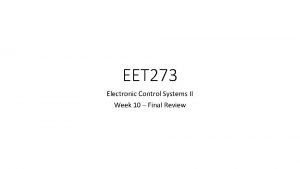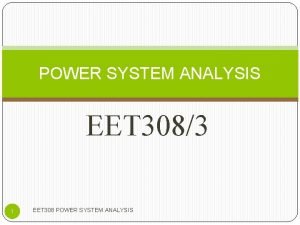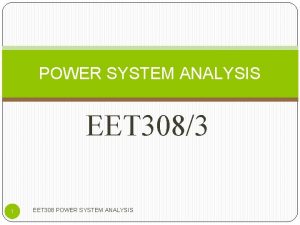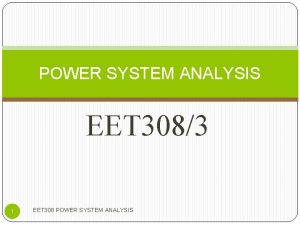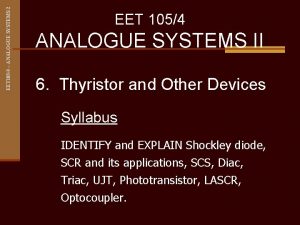EET 323 Electrical System Design Lecture 1 Introduction































- Slides: 31

EET 323 – Electrical System Design Lecture 1: Introduction to Electrical System Design Radian Belu, Ph. D

Lecture Objectives • Determine the estimated demand load for a specific branch, feeder, or service • Apply the demand factors to account for load diversity • Understand comply to the minimum NEC load requirements • Determine the demand load for 1 -phas and 3 -phase motors • Determine the demand load for household electric ranges, cook-tops, and ovens • Determine the demand load for household electric dryers • Determine service entrance ampacity requirements

Minimum Estimated Demand Load • Accurate estimates of the demand load on a particular branch circuit, feeder, or service are necessary to determine the required rate of these circuits. • Actual number of branch circuits and feeders is also based on the determination of the estimated demand load. • The required rules for determining the minimum estimated demand load for branch circuits, feeders, and services are discussed in the Article 200 of the NEC; The basic rule is that the branch circuit, feeder, or service must have a rating sufficient to supply the demand load to be served. • The demand load on a circuit is equal to the minimum estimated load as determined by applying the NEC minimums, or the actual load, whichever is greater.

General Lighting Load

Area (sq ft) = 50 ft x 100 ft = 5000 sq ft The total lightning load from the NEC is: The total lightning load based on the connected equipment is:



Notes: 1) Table 220. 3(A) applies to general lightning loads. 2) The load from general-purpose receptacle outlets in habitable areas of dwelling units, motels is permitted to be included with general lighting load for the purpose of load estimate. 3) For office building and banks, an additional load of 1 VA per square foot shall be included if the actual number of general-purpose receptacles is unknown. The designer may not know at the time of design what the final layout will be, so this extra provision for load must be included.


1) Section 220. 3(B) of the NEC requires a minimum of 180 VA be assigned to other general-use receptacle outlets that are not located in habitable areas or connected to a dedicated branch circuit. The 180 VA applies to a device located on a single yoke or mounting strap. 2) The estimated load is usually greater than the required NEC minimum of 180 VA. 3) Use common sense and judgment when estimating loads on circuits where you suspect large loads might be connected.

1) Tables 430 -147, 430 -188, 430 -149, and 430 -150 (see Chapter 13, for details) can be used for load estimated purpose of the electric motors (the full load current). 2) In addition, for feeders or branch circuits supplying multiple motor loads, a 25% of the load of the largest motor in the group must be added to the total motor load.




Load Estimation (cnt. ) • For the purpose of load estimation, the electric ranges are considered individually. • A counter-mounted cook-top and no more than two –wall-mounted ovens (all supplied from the same branch circuit) may be considered as a single unit for the purpose of load estimate (the ratings of units are added to determine the equivalent rating). • The demand load for household electric cooking appliances is taken from Table 220. 19 of the NEC. • For household electric ranges (or equivalent cook-top/oven) individually rated at and not over 12 k. W, the estimated demand may be determined form column A of Table 220. 19. • If the range (or equivalent cook-top/oven) has a rating over 12 k. W, but not exceeding 27 k. W, the demand from column A must be increased by 5% for each k. W in excess of 12 k. W.





Electric Clothes Dryers • Section 220. 18 of the NEC requires that the load demand for electric household clothes dryers be computed as being = 5000 VA or the nameplate rating, whichever larger. • The branch circuit supplying the dryer must have a rating sufficient to supply the demand load of the dryer. • Demand factors for more than one dryer connected to a given feeder or service are in Table 220. 18 of the NEC.

The concept of load diversity: Adding up the individual demand loads from the riser diagram of a facility will result in a total connected load apparent power (VA). However, the actual demand load will be less than the total connected load due to the fact that not all loads will be ON at the same time. For example considering the simple Riser diagram in Figure 3 -1


Figure 3 -1: Let assume that this is a riser diagram for a 2000 sq ft residence. There are 4 circuits for lighting and receptacles, 4 circuits for dedicated small-appliance branch circuits, and one dedicated laundry circuit. Dedicated circuits supply the microwave, overhead door operator, electric range, footer sump pump, laundry sump pump, dishwasher, airconditioning unit, electric dryer, refrigerator, garbage disposal, deep freeze, and electric hot water heater. The ratings of these large appliances are shown on the riser diagram. Lighting is estimated fro table 2203(A); Small-appliance branch circuit load (1500 VA each); Laundry circuit load (1500 VA each); Miscellaneous general-use receptacles estimated at 180 VA each. Total connected load is: 47. 673 k. VA

Notice: 1) Demand factors may be applied to portions of the total load due to the diversity of use that typically occurs in a particular occupancy. 2) Demand factors for general lighting loads are given in NEC Tables 220. 11 and 220. 13 (shown in Table 3 -3). Note that the use of these tables is not permitted when determining the required number of branch circuits for general lighting. These demand factors are only used to determine the total load, that typical apply only to services and feeders. 3) The lighting load that may be subject to the demand factors of Table 220. 11 is comprised of the following individual loads: a) Lighting load determined from Table 220. 3(A) b) Small-appliance branch circuit load (1500 VA each) c) Laundry circuit load (1500 VA each) d) Miscellaneous general-use receptacles that were calculated at 180 VA each




1. Utility rates schedules vary considerably among utilities nationwide, depending on type of generation, geographic, location, size and service voltage of the load being served, customer class, and other factors. 2. All rate schedules include a cost per k. Wh of energy consumption 3. Other rate schedules may incorporate charges relating to peak demand, power factor, time-of-day usage, interruptible service riders, and so forth.

Rates and Billing • Special rates are sometimes offered by utilities for street lighting, water heating, private outdoor lighting, traffic signals, and other types of specialized services. • The cost of generation power is directly related to the type of energy source used to drive the prime mover in generating plant. Geographic location of the generation facilities will have a direct impact on the type of prime mover used. • Most electric utilities separate the customer into three major billing classes: residential, commercial, and industrial. The ampacity and service voltage rating of the load generally determine in which class the customer would be billed.

Rates and Billing • The determination of customer classification is prescribed by rules and regulations usually approved by the state utilities commissions. • Within each billing class there may be several rare structures and schedules. • A rate schedule is simply the method by which the electric bill is calculated. Customers within the billing class will sometimes have a choice among several different schedules. • Rate schedule of your area can be obtained from the local utility company.

THE END of the Lecture Thank you for listening • Questions? • Comments
 01:640:244 lecture notes - lecture 15: plat, idah, farad
01:640:244 lecture notes - lecture 15: plat, idah, farad Eet tool
Eet tool English exit test
English exit test Eet205
Eet205 Wat eet een koala
Wat eet een koala Eet writing sample
Eet writing sample Eet 203
Eet 203 Eet 203
Eet 203 Eet 203
Eet 203 Eet 2023
Eet 2023 Eet 205
Eet 205 Eet machine
Eet machine Eet machine
Eet machine Wat eet een koe
Wat eet een koe Eet
Eet Eet 203
Eet 203 Ohalu
Ohalu Power system analysis
Power system analysis Wat eet een zeevarken
Wat eet een zeevarken Eet 203
Eet 203 Mgt 323
Mgt 323 Cse 323
Cse 323 Cos 323
Cos 323 Apnak bang
Apnak bang Elo-323
Elo-323 Protocolo h.323 caracteristicas
Protocolo h.323 caracteristicas Cecs 323
Cecs 323 Empire perfumes 323
Empire perfumes 323 H.323 protocol port
H.323 protocol port Mpls ventajas y desventajas
Mpls ventajas y desventajas Cos 323°
Cos 323° Internet telephony gateway
Internet telephony gateway














